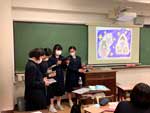An Irish Folktale in Japan / 日本でのアイルランド民話

Authentic communication is something we really value here at the school and I enjoy making lessons that allow students of all ages and levels to do what they can to communicate what they are really thinking and feeling. In order to do so, confidence and fluency is somewhat necessary. One activity we did recently in 7th grade to help students build their confidence and fluency was a kamishibai activity. In groups, the students had to decide on a Japanese folktale to illustrate and tell in English to the class. The purpose of this was to give the students a chance to share their culture with us while practicing their English. I think stories, especially folktales, are something that are important to share and pass along. It’s also something many of us like to learn more about when we meet people from different countries.
I know many of the main Japanese folktales but was surprised this time to hear the story of Urashima Taro. In Ireland we have a very similar story called Tír Na nŌg. Tír Na nŌg literally means Land of Youth and it has the same basic premise as Urashima Taro. The biggest difference is that Urashima Taro is set under the sea whereas Tír Na nŌg is set in the sky. It was a lot of fun to learn about this story and to be able to share in our common culture with my students.
Since that lesson, one 7th grader came to tell me that she was curious about whether there are other versions of Urashima Taro from around the world. She hadn’t yet found any but was excited to look for them. I believe that it’s not only impossible, but also a mistake, to try to separate culture from language. Without culture a language has no meaning, and so with that belief I strive to give our students every opportunity to share their culture, learn more about their culture, and to enjoy learning about other cultures all through the medium of English.
私は主な日本の昔話は大体知っていますが、今回浦島太郎の物語を聞いて驚きました。私の出身であるアイルランドにも “Tír Na nŌg (ティル・ナ・ノーグ)” と呼ばれるとても似た物語があるのです。 “Tír Na nŌg” は文字通り若さの地を意味し、浦島太郎と基本的に同じ設定です。最も大きな違いは浦島太郎では竜宮城は海の底にあるのに対して、“Tír Na nŌg” は空にあることです。この物語を知り、私たちの共通した文化を生徒たちと共有することが出来てとても楽しかったです。
この授業の後1人の中学1年生が世界に浦島太郎の他のバージョンはあるのか興味があると言いに来てくれました。彼女はまだ見つけたわけではないものの、探すことにとてもワクワクしている様でした。私は文化を言語から切り離すことは不可能であるばかりでなく、間違いであると信じています。文化がなければ言語は何の意味も持たず、だからこの信念を持って私は生徒たちに英語を通じて彼らの文化を共有し、さらに理解を深め、他の文化を学ぶことを楽しむための1つ1つの機会を全て提供しようと努めているのです。 Translated by R.W 高3